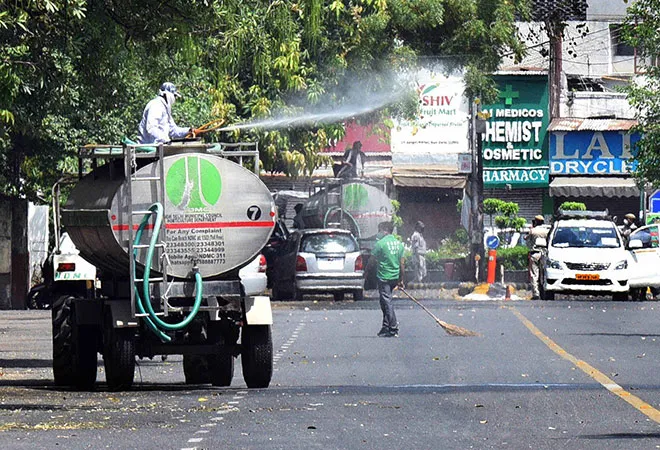
On March 4, 2021, the Ministry of Housing and Urban Affairs (MoHUA) released two reports—
Ease of Living Index (EoLI) 2020 and
Municipal Performance Index (MPI) 2020. This article presents the main results derived following the computation of the two indices, and the parameters considered for ranking cities. It is concluded that inclusion of new datasets that adequately capture diversity and inequality will be help in formulation of proper reform strategies.
The Ease of Living Index has been computed for 111 cities of India. Of this total, 49 cities have a population of more than a million, whereas the remaining 62 cities are below one million.
The index values have been derived on the basis of data (49 indicators) on four broad city characteristics/pillars, i.e., quality of life (education, health, housing and shelter, water, sanitation, hygiene, solid waste management, mobility, safety and security, and recreation); economic ability (level of development, economic opportunities); sustainability (environment, green space and buildings, energy consumption, and resilience) and citizen perception survey (conducted between February and March 2020 to confirm results of data).
As the report title and characteristics selected indicate, Ease of Living Index helps in knowing about the well-being of the citizens. It informs city governments about the gaps in urban policies, planning, and implementation initiatives, and offers an opportunity to improve the lives of citizens, as well as track the status of the sustainable development goals (SDGs).
The Municipal Performance Index (MPI) has also been calculated for 111 cities of India. In this case, 51 cities have a population of over a million, and 60 cities are less than a million.
Five aspects/verticals (covering 20 sectors and 100 indicators) were analysed for calculating MPI, namely governance (transparency and accountability, human resources, participation, and effectiveness); technology (digital governance, access, and literacy); planning (plan preparation, implementation, and enforcement); services (education, health, water and wastewater, solid waste management and sanitation, registration and permits, and infrastructure); and finance (revenue and expenditure management, fiscal responsibility, and decentralisation).
The MPI report describes the quality of urban governance (or performance of municipalities) in select cities. The data and analysis provided in the report will help municipalities in knowing the planning and management practices that require strengthening/reform.
The ranking of cities based on index scores reveals the following results:
- Ease of Living Index: Bengaluru and Shimla have been ranked number one in their respective population categories (i.e., above and below one million), whereas Srinagar and Muzaffarpur have received the lowest ranks.
- Municipal Performance Index: Indore and New Delhi (Municipal Council) have been ranked number one in their respective population categories (i.e., above and below one million), whereas Guwahati and Shillong have received the lowest ranks.
The framework for assessment of EoLI and MPI was formulated by MoHUA with the support of their knowledge partner—Institute of Competitiveness. Other partners in this venture are Smart Cities Mission Directorate, Karvy Data Management Services, National Informatics Centre, City Data Officers, Smart City Consultants, and Smart City Fellows.
Sector analysis provided in the report shows that Bengaluru has fared best in economic ability, level of economic development, and resilience. Its scores are also high for quality of life, education, housing, safety, sustainability, registration, and permits.
The municipal corporation is making efforts to run its schools, colleges, and hospitals efficiently. It has given free COVID vaccinations to over 50,000 persons. Sustainability issues are being addressed through rejuvenation of lakes, parks, and development of cycling tracks. The practices of participatory budgeting, single window clearance for building and construction projects, and local area planning are in use, and the development/master plan has been updated in the last 10 years. Being the IT capital of India, digital infrastructure has been created to provide online approval for setting up IT industries.
However, the city is under extreme risk of water stress, and the city government needs to address the problems of storm water drainage, public transportation, healthcare, master plan implementation, and enforcement. It is also noted that the municipality is yet to conduct an internal audit, and practice of incentivising green buildings is absent.
The scores for Shimla show that the city has done best in energy consumption and resilience. Other better managed aspects/sectors are quality of life, education, housing, safety, sustainability, environment, registration, and permits.
It is learnt that problems of water availability, pipeline leakages, and quality are being addressed. About 40 million litres of water is saved every day. The non-revenue water (NRW) has reduced by 10 percent, and the cost of water has come down from INR 119 to INR 90. It is ensured that chlorine level in supplied water is within range. The practices of participatory budgeting and single window clearance for building and construction projects are in use.
In May 2020, due to the lockdown and subsequent job losses, the Himachal Pradesh government announced
120 days (four months) job guarantee scheme for residents living in all urban areas of the state. Under the scheme, employment (in new and ongoing works, micro food enterprises, sanitation works, and projects under 15
th Finance Commission and Fifth State Finance Commission) has been provided to about 4,000 persons.
The city government, however, does not fare well in terms of formulating an updated development/master plan in the last 10 years, nor does it have a city plan based on Geographic information system (GIS). Further, the practices of local area planning as well as incentivising green buildings are absent. The report also informs that master plan violations, and transport-related fatalities, are very high in Shimla.
Indore’s performance has been outstanding on a number of fronts. Its scores are high for quality of life, which is reflected in sectors, such as education, housing, water and sanitation, sustainability, resilience, digital governance, registration and permits, and transparent and accountable governance. Its sanitation system is considered as one of the best in the country, and this success is due to the hard work of sanitary workers, officials, and citizens. The municipality’s revenue base is strong, and for this reason, it has received a high credit rating. It has generated income from carbon credit. It also has power to borrow or invest funds without state government approval. Its good performance in planning is understood from an updated GIS-based master plan prepared by qualified town planners.
Some aspects requiring attention in Indore are healthcare, mobility, economic opportunities, recreation, green buildings, storm water drainage, risk of water stress, violence and crime, and digital literacy.
The New Delhi Municipal Council (NDMC) has implemented a number of
smart city projects and is
using technology to strengthen governance. These measures have been initiated to ease the lives of citizens. This includes development of a mobile App (NDMC 311), which allows citizens to access various public services online, make payments and lodge complaints, quick response (QR) code based mechanism in public toilets to collect information from citizens regarding up keep of toilets, digitisation of records, creation of a GIS portal for better planning of services, technology enabled smart classrooms, GPS enabled garbage monitoring through integrated command and control centres (ICCC), and adoption of block chain technology for registration of births and deaths.
Delhi’s scores are, however, low for storm water drainage, encroachment free land, safety, air quality, and enforcement of master plan.
The ranking of cities based on EoLI and MPI scores, the analysis of data and information on numerous urban aspects, and opinions generated through citizen perception surveys, provided in the above-mentioned two reports, are important steps towards building a better understanding of conditions prevailing in Indian cities, as well as the quality of urban governance.
The city scores clearly show urban sectors (i.e., education, health, water supply, sanitation, mobility, etc.) and governance practices (i.e., finance, planning, technology, participation) that are doing well, and those requiring urgent attention.
It is unfortunate that many cities situated in resource-rich and favourable climatic regions of India, including Srinagar, Guwahati, and Shillong, have received the lowest scores. Further, it is noted that most cities have received full score for resilience. The basis for scoring this parameter might require a rethinking in the light of inadequate administrative preparedness during challenging times—COVID19 stress, city flooding, building fires, etc. It is also surprising to note that a separate indicator on rainwater harvesting has not been considered in this assessment.
In conclusion, it may be stated that computation of scores for all 4,000 plus urban centres of India, and inclusion of new datasets that adequately capture diversity and inequality, will be helpful in development of urban reform strategies.
The views expressed above belong to the author(s). ORF research and analyses now available on Telegram! Click here to access our curated content — blogs, longforms and interviews.



 On March 4, 2021, the Ministry of Housing and Urban Affairs (MoHUA) released two reports—
On March 4, 2021, the Ministry of Housing and Urban Affairs (MoHUA) released two reports— PREV
PREV


